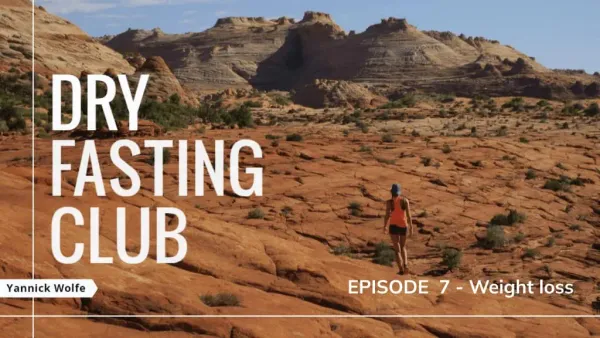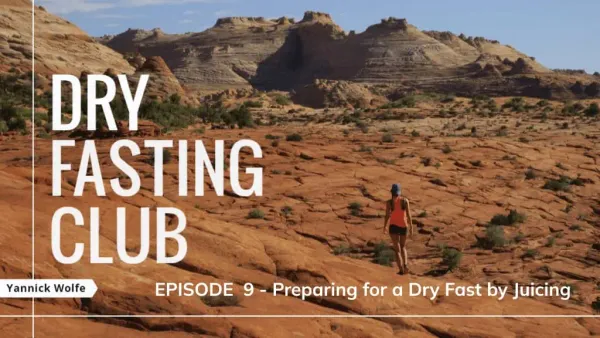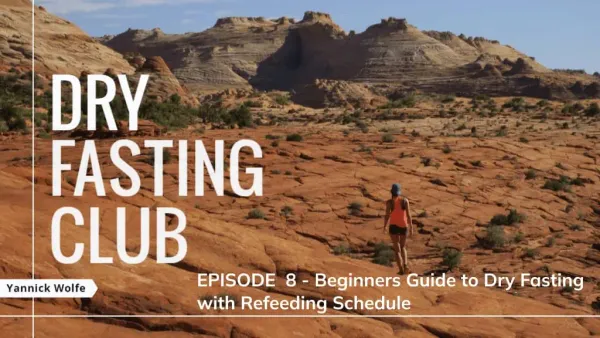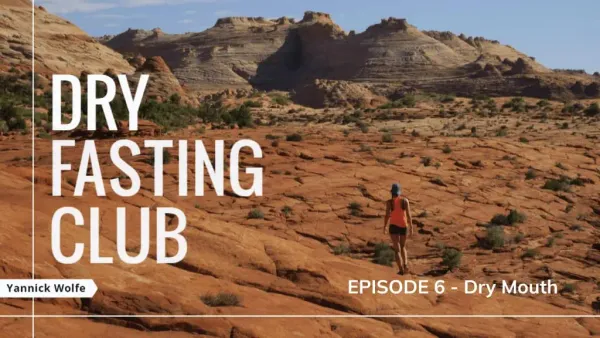Introduction
Welcome to the Dry Fasting Club and the beautiful world of dry fasting, I’m Yannick Wolfe and I hope to be able to guide you on your dry fasting journey.
Before we continue, it’s important to note that the information provided here is done to the best of my experience and research, however, it should never be taken as medical advice. You should always speak to a medical professional about your decision to attempt fasting in the first place. Please treat this information as entertainment only.
I’d also like to let everyone know that if you are interested in fasting, specifically dry fasting; make sure you join the Dry Fasting Club’s discord group. It’s where you’ll find expert fasters that can answer most of your questions. As well as like-minded people that are also on the fasting journey. The link to the discord, as well as references to the topics discussed will be in the notes. Ok, let’s get started.
People’s experiences with dry fasting and weight loss
I’m trying a new thing this week. I think it might be more entertaining and overall better to start each episode with a few different people’s opinions that I found online. This way, you can keep different viewpoints and experiences in the back of your mind as I continue through the topic. Let me know in the youtube comments if you like or dislike this idea.
The first user writes about why dry fasting is better than water fasting:
Dry is 2-3x quicker than water. The people who say the fat loss between the two are the same are simply wrong. If you say the fat loss is the same across both dry and water then you are essentially saying that metabolic water doesn’t exist.
I agree with this statement. Although we do have pockets and cavities of water throughout the body, it’s more like intra and inter-cellular water. Some of the water is really hard to get to, and can start getting released deeper into the fast.
However, once your glycogen is depleted, your weight loss does start to include a lot of fat loss. Did you know that each gram of glycogen is composed of 3 grams of water? This is why there’s a massive weight loss when either starting a dry fast, water fast, or even just stopping carbohydrates.
Another user writes:
If the goal is weight loss, I’d stick to OMAD + light cardio.
Fasting can be too discouraging. Even after successful (5+ days) water fasts, I found myself tempted to eat bad things, “because I deserve it”. In my experience OMAD and light cardio are way more effective for permanent weight loss, and about 100 times easier.
I’m Someone who had successfully dry fasted, please correct me if I’m wrong. I’ve never dry fasted over 24 hours.)
My only issue with this perspective is that the commenter has only done a 1 day dry fast, and is comparing fasting with their 5 day water fast experience. It’s important to remember that water fasting and intermittent fasting for weight loss sucks because of three major things:
- Fat loss is slower
- Fat cells are not efficiently destroyed on a water fast, so it’s easier to regain them
- You are more hungry, so mentally it is exponentially harder. This is more on water fasts than intermittent ones.
It’s definitely true that OMAD is easier, even though it takes much longer to achieve. You still get to be sort of a glutton at the end of the day, (or whenever you dedicate your one meal). It’s harder because it can take months to get to your desired weight.
So it comes down to the question if you’re disciplined enough to OMAD for a long time, or do you want to get results quicker? With OMAD you have a lot more room for error as well. You can eat slightly more junk and it will still work because the OMAD continues for so long. Because it’s over such an extended period of time, the blips of random binge snacking get flattened when you average it out.
The Third user writes:
You will lose between 1.35 to 1.5kg of bodyweight per day of dry fasting. It is largely independent of activity level or body size. Your burn rate is in the tens of thousands of calories per day. I’d say you burn until you have single digit body fat and then it slows down.
Commenter is not taking into consideration electrolyte related water loss, glycogen loss, sweating, and urination. He or she is assuming that nearly every gram lost is because of the body creating metabolic water. Although he is correct that 1kg of fat would be 9000 calories, it doesn’t mean you’re burning 9000 calories a day. In the first 2 days you will lose mainly water weight, even though some fat starts to get burned as well.
You level out for the next few days at approximately 1 kg of weight loss. A lot of this is fat, but it’s also a small amount of water as well. The body goes into protein conservation during dry fasting which is great, so we don’t have to worry much about losing strength.
Why is Fasting the best way to lose weight
Everyone is always looking for a shortcut for whatever ails them in life. Weight loss is no different. Most people who suffer excessive weight are non-disciplined in the first place. Because with discipline, you will usually be able to maintain a healthy weight.
The problem here is that the non-disciplined person looks for a shortcut, and gets lulled into the world of weight loss scams.
“I’ll sell you this pill for 100$ and you won’t have to change a thing! Subscribe to my diet meals and your pounds will fly! Buy my supplements, necklaces, and watches so that you can lose weight while you sleep!”
The world of weight loss scams has been ongoing for a long time. The common phrase used by these MLMs and weight loss gurus is: “There’s a sucker born every minute”. Nothing, and I repeat nothing will beat good hard discipline, a good diet, and fasting. In fact, I kind of consider fasting cheating. It’s that good.
Fasting helps you cut corners, and it helps in the following areas:
- In building better eating habits, it’s just so much easier to eat healthier, when you exit a fast and every single vegetable sings to you. Eat me!
- The fastest weight loss you can achieve, and actually keep some of it off. Water fasting and other diets are notorious for gaining it back.
- It’s not that complicated. You literally are asked to do nothing, no food no water.
- Saves you money while not giving it to some greedy diet and supplement companies. If you incorporate fasting into your life you will actually be able to notice a budgeting difference.
- Oh and it heals you at the same time. Who wouldn’t want free maintenance on their body?
Overall, I firmly believe that fasting is the most effective way to lose weight quickly. Other fad diets put your body into starvation mode, while fasting is the only thing that puts your body into a hibernation state that preserves muscle, and activates regulating mechanisms that will make it as safe as possible for you.
Starvation mode is scary. Fasting mode is not.
Losing weight myth
There’s this myth going around that fasting is not effective for losing weight. It says that most of it is only water weight and it will come back right after you start eating again.
This is partially true. There’s no doubt that when you abstain from any food, specifically carbohydrates, your body starts to dump electrolytes and glycogen (both help you hold on to water). With that comes the crazy weight loss associated with dumping water. When you start to consume carbohydrates along with sodium and other minerals, your weight will bounce back.
However, your fat content should not bounce back, depending on how much fat you lost. If you maintain a healthy diet, it will make things much easier. The refeed is crucial for this to work correctly.
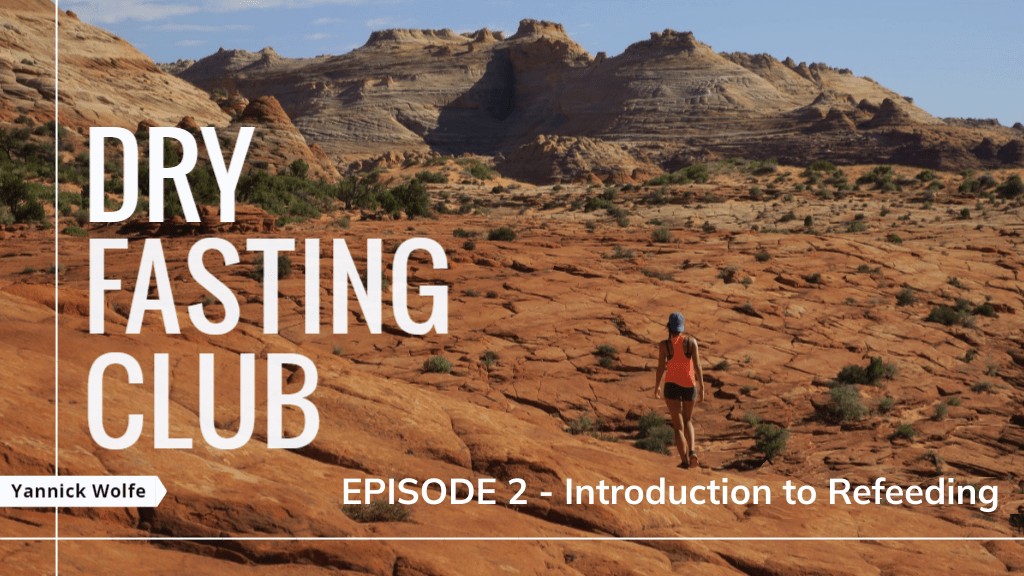
Proper refeeding
Here’s the biggest problem. Your metabolism slows down during fasting, as it does on any calorie-restricting diet. That’s why there are specific steps to refeeding. For fasting, it’s much easier to see the stark differences. Your digestive system shuts down, so gorging yourself is not an option unless you want to land in the hospital.
This makes it already better than other diets, where you can easily overeat in between sessions or after completing it. You’re basically forced to eat smaller portions. If you exit the refeed carefully and slowly with small meals that gradually get bigger, you will speed up your metabolism again. But, If you continue to eat healthy, well portioned meals, you will stay leaner. Then add working out and more fasts in the future and you will be well on your way to a full body recomposition and healthier life.
One more thing to mention with calorie-restriction-dieting vs fasting to lose weight. When heavily calorie-restricting, your body never enters a form of ketosis.
Ketosis is one of the main mechanisms that make losing weight safer. It forces the body to scavenge misfolded proteins and damaged cells, so it is also doing a sort of cleaning of the body. This cleaning provides necessary nutrients wherever they are needed.
However, doing calorie restriction doesn’t always induce ketosis, so you are losing weight very slowly. The scary part is that you are not getting enough nutrients, while also increasing cellular damage.
Stages of dry fasting with weight loss amount.
You can expect to lose approximately 1 kg of weight per day of dry fasting. In the first 2 days, some people lose up to 2kg of weight because it is accompanied by electrolyte and water weight loss. After the first two days, it should start to slow down to approximately 1 kg of weight loss, this depends on the person, their weight, their metabolism, level of activity, etc.
Consider health issues
Another thing to note during your dry fast is that if you are very toxic and unhealthy, you may run into blocks that may become dangerous. This usually occurs between the fourth and eighth day, but it may arrive earlier as well. If you stop losing weight, and you become extremely weak, to the point that moving is a big chore, you may have arrived at one of these toxic blocks. Where the body is releasing too many toxins and you cannot keep up.
This is also why it’s so important to prepare for the fast in advance by following proper preparation practices (say that three times quickly) Proper. Preparation. Practices. Such as enemas and liquid diets. This is a step a lot of beginners skip. I highly advise you to consider it. It makes things much easier.
So if a toxic block occurs, you will need to break the fast with water. After a few hours move on to diluted organic fruit juices to bring your body back up with carbohydrates and normal functioning. This is necessary to let the body deal with the toxin buildup without building up even more toxins.
So basically your body, when its losing weight quickly, eats away at your fat cells. A lot of toxins, heavy metals, bacteria, viruses, funguses, biofilms, and more are scattered throughout your cells, but most of them reside in your fat cells and mucus. Think of the fat cells as holding blocks in a prison.
Refeeding instructions and why you should follow them
If you’re running into these you will need to refeed for the necessary amount of time. This means 2x the amount of time you dry-fasted. If you did 5 days, then you should refeed for 10 days. Then you can go back for another attempt.
These 2X rules are not followed very strictly by a lot of people. It’s important to be honest. Personally, I’ve shortened the refeed many times. I think you should strive for the full duration, but as long as you’re trying to maintain smaller meals and eat healthy, you are technically still refeeding.
However, remember. Fasting is destruction, refeeding is construction. Most healing happens during the refeed, you don’t want to overburden the digestive system with too much too fast, and you want to make sure you’re feeding it good food.
No food or water. The first stage begins your journey of removing food and water from your environment.
📌 First day of dry fasting – Stop eating and drinking
Depending on if you are doing a soft or hard dry fast, you may also abstain from all contact with water. This would include no showers, no teeth brushing, and no bathing in water. Weight loss is expected to continue to be around 1.5 kg per day, which is about 3.4 pounds.
The loss is mostly water weight as your body uses up its stored water, drops electrolytes, and glycogen while no external water is being consumed to replenish it. It also depends on your level of pre-fast hydration. The more you’ve hydrated, the larger the drop will be over the next two days. Also urine levels are highest on the first day, and they are also dependent on your level of hydration.
📌 Second day of dry fasting – Weight loss and ketosis
Since your body is now without food and water for over 24 hours, you are now entering into deeper ketosis. As your body quickly eats up glycogen and starts to run low on stored water. Autophagy has started to increase rapidly. Weight loss is expected to be around 1-1.5 kg per day (2-3 pounds).
The body is still dropping some stored water but is slowly starting to transition to endogenous water production. This water comes from your fat cells and starts to build up ketones in your blood. The body starts to become more acidic. Day two of a dry fast is recognized by possible headaches, nausea, and urges to eat and drink. This is due to multiple factors.
Blood sugar levels drop drastically, the body starts to burn fat as fuel instead of carbohydrates, and possible detoxification symptoms start occurring as autophagy increases. As the day progresses, you get less and less hungry. Thoughts of drinking water may start to occur. Urine production slows down aggressively and starts to turn a deeper orange as internal water runs out. Urine may be cloudy due to alkalinity, yeast infections, or other factors.
📌 Third day of dry fasting – Acidotic Crisis
The Third day is a milestone. You definitely level up once you’re able to surpass 72 hours of dry fasting. So what happens on day 3? Weight loss slows down a bit because glycogen is gone, and you’re definitely starting to burn more fat than previously.
The body switches to fat for water and nutrition. Headaches and problems from the first two days tend to disappear. Mind clarity increases sky-high. The brain feels oiled and running in full gear. Sleep starts to get affected. Feelings of thirst increase while hunger tends to disappear.
For weight loss, you are now glycogen depleted, and your body has adapted to the fast. This is when you feel great. Getting through those first 2 days is so tough. But this is where the fat starts to fly. How long you can maintain here is up to you. Expect to lose about 1 kg of weight per day, which is about 2.2 pounds. The next few days will all be similar. If you’re fatter, you may lose more weight than if you are already fit.
📌 Fourth day of dry fasting – The body fires up
Day 4 is a fun day. This is when you can start to feel the dry fasting heat. It’s great during the colder months when normally you’d want to bundle up, but instead you feel refreshed by the cool weather.
Your sleep may be affected, and it may take considerable effort to fall asleep. Some attribute this to higher levels of cortisol from the fight or flight response circulating in the blood. Others believe that as your body is no longer digesting, that it is cruising at max ketones and endogenous water. So, your body no longer requires as much sleep. Weight loss is expected to continue to be around 1 kg per day (2.2 lbs). Urine levels remain a similar color and amount to day 3 of dry fasting.
📌 Fifth day of dry fasting – aches, and pains
The fifth day of a dry fast is known as the aches and pains day. Typically around this day, you start to feel pain in certain body areas and organs. Many experienced fasters speculate that the aches and pains identify the areas that require healing. These areas are undergoing targeted autophagy and possibly other mechanisms too. Heat increases a little bit more than on the fourth day and blood pressure may fluctuate depending on the person. Weight loss is expected to continue to be around 1 kg per day (2.2 lbs).
Following days:
Be aware weight loss will slow down as you get into a longer and longer dry fast. These dry fasts are undertaken with the main goal of healing chronic illnesses. If you are looking for fast and effective weight loss though, you will want to end it around day 5, then you will need to refeed correctly, and then undertake additional fasts as long as you still have weight to lose.
It’s really up to you on how long you want to fast and how quickly you want to lose weight. Another simple strategy is also to do a 1 or 2 day dry fast and transition that into a few day water fast. You can do this many times, and it’s a much safer approach.
Muscle preservation on dry fasting
I would love to provide some studies showing that muscle retention is strengthened during a dry fast, but unfortunately there are none or are very hard to find.
This is the big disadvantage of practicing dry fasting. It doesn’t provide the scientific proof that a lot of people need. It’s very difficult to convince someone who is very risk averse to try something that has so little research behind it.
Suffice to say, the main literature you’d need to read would most likely be in Russian, or you’d have to take Sergey Filinov or August Dunnings word for it. The fact of the matter remains. For anyone who has dry fasted for significant periods of time, we are aware that fat loss and water loss is epic, while muscles seem to stick around.
I test this concept out every time I dry fast – specifically when I work out. It’s been the same a year ago, and it’s the same now. I am able to lift the exact same weights for almost the exact same repetitions while dry fasting, and even during the refeed. I obviously try not to push too hard, but whenever I’ve tried to test my limits, I was surprised that I had similar levels of strength.
My experience
Let me give you an example: Just recently I lost 18 pounds of weight on a 5 day dry fast. The last hour of the fast, so hour 119, I went into my home gym and did shoulder presses and a few other exercises at the exact same weight I did them before the fast AND...
I did more pull ups than I could do right before the fast.
Mind you, I was 18 pounds lighter. But hopefully this experience makes you realize that even if there is minimal muscle loss, the fact that I could do that is mind blowing.
I firmly believe that once the gym community gets a grasp on the effectiveness of dry fasting for muscle preservation, we’ll have a new health craze bonanza spring up. Although breaking through the “3 days without water will kill you” mental block will probably still keep 99% of people from trying it. Dry fasting as a way to skip the grueling months of cutting that so many weightlifters have to go through. Then you can bulk on healthy foods, and rinse and repeat.
How to best prepare for dry fasting weight loss
I haven’t talked about this enough in previous episodes but I will start bringing this up more often. Enemas are a topic that scares a lot of new people coming into fasting. I’ve been there, so I know. Avoiding even thinking about doing an enema is how most people approach it.
However, if you’re going to be doing extended fasts that are 5 days and up, you should really have a second look at them.
Without an enema you will have leftover stool and blockages in your digestive system when you start the fast. These blockages will ferment, and release gasses and toxins that will make your fast harder. You will feel more nauseated, bloated, have more headaches, and more. They will most likely be the reason you end the fast earlier than if you had cleaned yourself out.
Luckily there are a few different levels of approaches that you can take in regards to cleansing your colon.
The easiest way
is to prepare for the fast by going on an all liquid diet. An organic juice fast for example, (use a juicer, so that there’s minimal pulp) will work wonders and even start some weight loss and healing before you jump into dry.
Another thing to remember, if you’re skipping the liquid preparation diet, make sure you do not eat meat, cheese, and heavily processed oily foods and sweets a few days before you start. These foods sit in your digestive system for a long period of time.
Even though carnivores claim that meat is the best food for you, it doesn’t change the fact that it is tough on your digestive system. Don’t get me wrong, I’m well aware of the anti-inflammatory effects of a carnivore diet and there are a lot of good arguments for it. But it does not change the fact that meat can stay in your digestive system for up to 72 hours. If you have to eat meat, consider blending it into a paté.
The second, more hardcore step
is to do water enemas to clean out your colon. You will want to do one the night before your fast, and the morning of your fast to make sure you are really clean in there. Look up how to perform them.
They are actually much simpler than you think, and not even that gross. I’ll do a small graphic description, since a lot of people are clueless when it comes to enemas.
- You’ll have a sort of IV faucet of water set up on your shower curtain rod. Insert the drip you-know-where, while laying down in your tub with your butt up or sideways.
- You can place pillows inside your tub or you can even do all of this lying down sideways on the floor over a towel.
- After emptying the IV bag of water, you’ll wait a few minutes and then go to the toilet.
- BAM! You’re done and can prepare for an easier, healthier fast.
One of the final preps
that are very important and can easily be the difference between a successful fast and one that had to be cut short would be to start avoiding sugar and caffeine a few days before the fast. Try and induce the caffeine withdrawal headaches early on, so you don’t have to worry about them during the fast.
I’ve found that for people who are coffee obsessed. You’ll want to transition to green tea a week or two before the fast and try to downregulate it.
The advantages of dry fasting over other weight loss methods
- Faster weight loss because the body is creating excess energy by trying to oxidize fat cells to create metabolic water. This water is live water and perfectly clean as opposed to potential toxins and microplastics in external water during a water fast.
- Fat cells ripped apart more efficiently since the body is actively trying to get metabolic water. This makes it easier to keep the weight off after dry fasting compared to water fasting. As long as the refeed is done correctly.
- Dry Fasting is easier to undergo because there’s no constant feeling of hunger. You literally do not go through nearly as much hunger pangs as with water fasting. Eventually you will crave water, but it’s at a later stage.
- The skin does not become as saggy or flabby after the weight is lost. Losing a lot of weight while water fasting leaves you with loose skin, while dry fasting is actively rebuilding your skin layer as you lose weight. You can still get loose skin with dry fasting but it is drastically less than with water fasting.
- During dry fasting, weight loss is accompanied by an improvement of the body and overall well-being. Dry fasting is the ultimate anti-inflammatory since inflammation requires water. Anyone with any mucous or sinus issues will notice on day 3 and up that nearly all sinus problems start to disappear.
- You can always turn a dry fast into a water fast, and still reap a lot of the early benefits, making it very flexible.
- The simplest method of losing weight. Do nothing, eat nothing. Obviously there’s a caveat to preparation if you’re going to go on a really long one.
My personal experience with dry fasting and weight loss
Before dry fasting I had usually maintained my weight around 195 pounds throughout my life. It’s always been a mix of muscle and fat. I’d have always considered myself skinny fat. I ate healthy, but I would snack here and there. Even though I did long water fasts, I would still quickly come back to my 195 pound threshold.
Since starting dry fasting I have been hovering around 185 pounds as my new normal, no matter if I eat a lot or not. I eat healthier, and I crave healthier foods now. There was a new level that unlocked in my mind. I believe there’s a spiritual aspect, but all in all, I had rewired my brain, and I believe I had burned away fat cells. Not to mention I feel healthier than I had in over 10 years.
My first dry fasts that were around 72 hrs to 120 hrs were not done with correct refeeding and I still was in a better place than when I started. I do believe that the mistakes you make in the beginning are necessary and you need to remember that. It’s not about doing it perfectly from the start, it’s about starting. Beware of analysis paralysis.
And this is a good segue into my dry fasting thought of the day.
Dry fasting thought of the day
I was reading about John Locke and a quote of his really resonated with me and dry fasting in the way it’s viewed as crazy, dangerous, and simply stupid. Locke said:
New ideas are always suspected, and usually opposed, without any other reason than because they are not already common.
Remember this. People who change the course of history are simply people like you and I who believe in themselves and their idea, push forward, and break through barriers. It’s much easier to get behind an idea that has already been expressed and put forward. Remember this when people try to put you down for trying new things like dry fasting. Raise your head up and push onwards.
Summary
To summarize everything:
Dry Fasting will make you lose weight the quickest. It’s important to remember that the first 2 days are mostly water weight, but as you continue the fast, you start to lose almost 1kg per day, and a lot of it is fat.
If you don’t refeed correctly after a longer fast, you will gain a lot of water weight back because of sodium retention. Your metabolism will be slower as well, so make sure you very gradually up your food intake to match the metabolism that is waking up. Dry fasting is basically a cheat code to losing weight while also making you healthier. Just make sure to do it correctly.
A few words at the end
Well, we’re at the end of the episode. As always, references are in the show notes. If I’ve convinced you to try a day or two of dry fasting, maybe I’ve saved you some money on groceries or some bottled water. If you would like to support this podcast and my work at exploring dry fasting topics, I have a link in the show notes where you can donate and buy me a coffee. You’ll also get access to a private server for members. Leaving a 5-star and a like or a comment goes a long way too. If you have questions, feel free to leave a comment on the youtube podcast episodes and I’ll try to answer them and compile the best ones into future videos.
That’s it for this episode. I hope you enjoyed it. Thanks for listening, make sure you join our discord, telegram, or facebook group. Good luck on your dry fasting journey!
References
Duration of fasting – More doesn’t mean better
Does Fasting Release Toxins in the Body?
